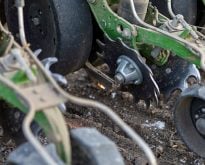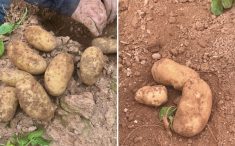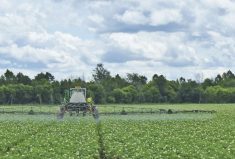The verdict is out on split nitrogen applications in Manitoba corn. After years of small-plot and on-farm field-scale trials, it appears that split N can provide some flexibility for farmers to adapt to conditions as the season unfolds but, generally, they should only expect the practice to maintain yield, not increase it.
“For many people, they have found it’s a practice that they might keep on the shelf, just in case,” John Heard, crop nutrition specialist with Manitoba Agriculture and Resource Development, told a recent field day near Manitou, Man.
“What we learned generally in our trials was that providing you’re not doing your split application too late, and you are not damaging crops, the yields can be exactly the same as if you put your N up-front. So, there’s no yield penalty but also there’s no yield advantage to doing that.”
Read Also

Riding the tariff roller-coaster
What producers are doing to minimize the risk created by ongoing trade uncertainty.
The Manitoba Crop Alliance funded split N application trials from 2017 to 2019, including 12 on-farm trials across Manitoba in 2019 conducted by Tone-Ag Consulting in co-ordination with the small-plot trial research by Heard and Don Flaten at the University of Manitoba. The aim was to quantify the agronomic and economic impacts of split N applications in corn under Manitoba conditions, which turned out to be drier than normal in the trial years.
[RELATED] Fertility tips for corn
The Canadian Fertilizer Institute’s annual fertilizer use survey has shown that the number of farmers doing split N applications in corn dropped from 12 per cent five years ago to four per cent in 2021. Although that might suggest that many have abandoned the practice, Heard says it more likely indicates that farmers are hedging their bets.
“Maybe, when it came time to put on the split (N), they looked at the crop and said, ‘We’re in the middle of a drought, there is no further yield potential to be had there. I have enough on already to grow a 100-bushel crop, and there’s no use of fertilizing for a 115-bushel crop,’ so they just held back. I consider that one of the real attributes of that type of system. You’re not putting all your money out there out front. So, in a dry year maybe there is a potential saving.”
In a wet year like 2022 in Manitoba, with more in-season losses of N, farmers had the opportunity to supplement the crop to ensure they fertilize to their usual rate, or maybe even add a bit more if they anticipate more losses.
“That’s the benefit to the split application system,” says Heard. “It’s like betting on the hockey game at the end of the first or second period. You have had the chance to see how the game’s going and you can decide that I’m going to bet with less money or bet with more money because you already have some indication of where the yield is going to go.”
How much and when?
What the research has determined is a split N application should be done as early as possible, given Manitoba’s shorter growing season.
“Going early is a good idea in that we’re in a short growing season, so we don’t want to withhold nitrogen very long, especially if you have reduced your upfront amount,” Heard says. “We often say for people that put down things like anhydrous ammonia in side-dress, you could start as soon as the crop is four inches tall even. One of the other reasons for doing that is, we can get a whole bunch of rain and then the fields may be too soggy to get into with heavy equipment. So, if the ground is fit, and you’ve got the opportunity, then you go early because if you can’t get in, the corn can quickly go from being six inches to a foot tall, and then there might be more crop injury.”
Farmers forced to apply a split N application later in the season would likely have to go to a liquid form that they can dribble band between the rows or a Y-drop system, if they have the equipment to do it.
“Flexibility is a good thing, but there’s only so much equipment a farmer can be expected to own,” Heard says. “So, if your equipment is such that you need to have it done before the crop gets knee-high, well then you’re better to start early so that you aren’t damaging the crop.”
So, what are the application rates for a split N application in corn? How much goes upfront and how much should the grower hold back? There are two options, Heard says.
“You could put down two-thirds of the intended amount upfront, and that gives you a fairly wide window to come back in and put the rest on,” he says. “The other option is to put a third down in advance, and that just means that you are committed to come back earlier in the growing season. So, you either start with two-thirds and end with a third or start with a third and end with two-thirds, and you put that on early.”
How much is N a third or two-thirds? That depends on the soil test.
“Corn in Manitoba, based on the research, requires between 150 and 190 lbs. of total N,” Heard says. “Last year, the soil test N tended to be a lot because there was a lot of carryover with the drought. So, the farmer takes into account the soil test and then he can apportion it based on those splits.”
Adjusting rates?
Mario Tenuta, senior industrial research chair in 4R Nutrient Management and professor of soil ecology at the University of Manitoba, says split N applications and other 4R strategies to reduce N losses could bring benefits other than yield.
“By using the 4Rs, if they are reducing their N losses, they can consider adjustments to their rates,” he told the field tour. “If they start something (new), maybe for the first three years they don’t change their rates and see if anything changes, and if they don’t see a yield benefit from it, they could consider dropping their rate by the extra cost of the practice and see if they recover their money.”

Tenuta and research colleagues in Quebec and Ontario have been looking at how split N applications (as well as other 4R nutrient management strategies such as slow-release fertilizers and nitrification and urease inhibitors) in corn and potato crops can help to reduce greenhouse gas emissions, which the federal government has set a target to reduce by 30 per cent by 2030.
That research has shown some promising results in reducing N2O emissions using split N.
“Split application of N is beneficial in a majority of years to reduce N20 emissions, and the drier the growing season, the more of a benefit there is to the split application because we are putting a portion of the N on under drier soil conditions because the N20 that is emitted from bacteria in the soil by denitrification is lower,” Tenuta says.
Averaged over several years, results have shown a 31 to 33 per cent reduction in N20 emissions in corn when using a split N application, exceeding the government targets.
“In terms of the N20 decrease per unit of N added to the soil, the reduction is even higher, around a 40 per cent increase over spring application,” Tenuta says.
Incentives
Split N applications and other 4R N-management strategies are already starting to be incentivized. As an example, the Manitoba Association of Watersheds is the province’s lead organization in delivering the Prairie Watershed Climate Program (PWCP) funded through Agriculture and Agri- Food Canada’s On-Farm Climate Action Fund (OFCAF). From February 2022 to March 2024 the PWCP is providing up to $40 million to Manitoba farmers who are adopting best management practices (BMPs), including N management strategies.
Individual farmers can access up to $75,000 for eligible BMPs. The program began taking applications in August 2022 and applicants must provide a plan developed with a 4R-certified agrologist or crop advisor. Only farmers using 4R practices for the first time or those expanding acres under 4R are eligible.
The Canola Council of Canada also administers OFCAF and recently announced a program that will offer incentives for best management practices. Farmers can receive up to $6,000 per BMP and two are eligible a year.
There is also a regulated carbon market in Canada where farmers can get paid for their efforts to reduce emissions, although Tenuta says it’s unlikely individual farmers will want to trade credits on those markets in the near term and will likely use some kind of aggregator — possibly an agronomist with several clients who can combine the credits and trade them on their behalf.
Corn plant population trials
Manitoba Crop Alliance is also funding on-farm research into corn plant populations. Now in its third year, the study is looking at three seeding rates — the area’s standard recommended rate, 10 per cent higher and 10 per cent lower — to determine if there are any agronomic or economic advantages between the different rates.
At the 11 on-farm locations across Manitoba in 2020, only four sites showed a statistically significant yield difference, ranging between 3.4 and 3.5 per cent. The yield increase resulted from a higher seeding rate in three sites where the normal seeding rate targets 30,000 plants per acre (ppa). The fourth site showed an increase with a seeding rate lower than the nor- mal for that area, which targets 40,250 ppa.
“I would suspect that at the higher ppa (in the fourth site) that the plants were competing against themselves at the high and normal rates, as compared to the low rate,” says MCA research trial specialist Daryl Rex.
In 2021, 10 trials showed no significant yield differences across all the sites.
These two years were drier than average, so it will be interesting to see how results compare from the 2022 trials, under wetter conditions, Rex says. In the meanwhile, it appears that seeding rates being recommended to target corn plant populations for various areas in Manitoba seem to be correct at this point.
– This article was originally published in the September 2022 issue of the Corn Guide.
















